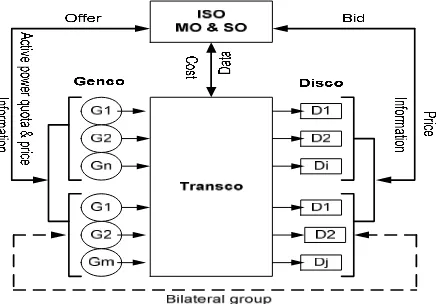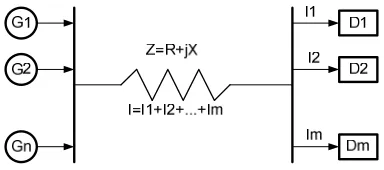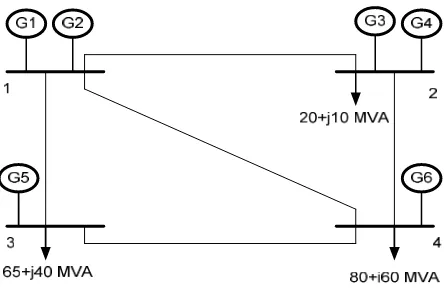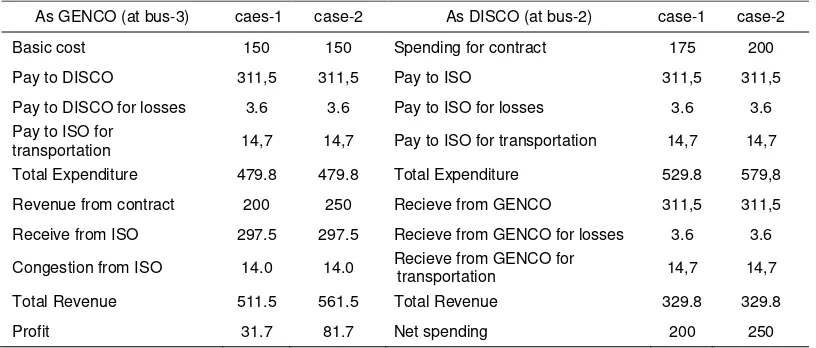ISSN: 1693-6930
accredited by DGHE (DIKTI), Decree No: 51/Dikti/Kep/2010 667
Implementation of Electricity Competition Framework
with Economic Dispatch Direct Method
Hermagasantos Zein1, Yusra Sabri2, Ali Mashar3
1,3
Energy Conversion Engineering Dept., State Polytechnic of Bandung (POLBAN), Indonesia
2Electrical Engineering STEI, Institute Technology of Bandung (ITB), Indonesia
e-mail: [email protected], [email protected],[email protected]
Abstrak
Secara teknik, bisnis listrik dalam struktur kompetisi lebih komplek dari pada stuktur teritegrasi secara vertikal. Suatu kerangka kompetisi harus dirancang untuk mengimplementasikan strategi-strategi penawaran dengan perhitungan-perhitungan listrik secepat mungkin (tidak lebih dari 15 menit). Tulisan ini mengusulkan suatu krangka kompetisi dengan perhitungan-perhitungan listriknya, dimana dalam kerangka tersebut telah mengakomodasi kontrak bilateral. Optimasi harga energi listrik dalam tulisan ini dihitung berdasarkan ekonomi dispasch metoda langsung guna mendapatkan hasil perhitungan secara cepat. Metoda-metoda yang dibuat akan disimulasikan pada suatu sistem 4 bus. Hasil simulasi menyatakan bahwa implementasi kompetisi tenaga listrik yang dibuat tersebut sudah sesuai dengan harapan. Jadi bisnis tenaga listrik dalam struktur kompetisi dapat direalisasikan dengan baik.
Kata kunci: kerangka kompetisi kelistrikan, implementasi, perhitungan-perhitungan listrik
Abstract
Technically, electricity business under competition structure is more complex than that of vertically integrated one. A competition framework has to be designed to implement bidding strategies with electrical calculations as quickly as possible (not more than 15 minets). This paper proposes a competition framework with the electric calculations, where a bilateral contract has been accommodated. Optimal energy price in the paper is calculated based on direct method of economic dispatch to obtain the result very quickly. The proposed method has been simulated to a 4-bus system. The simulation results show that the method works well and complies with the expectation. Therefore, electric power business under competition structure can be well realized by the proposed method.
Keywords: electric calculations, electricity competition framework, implementation
1. Introduction
Electric industry structures in many countries have been changed dramatically for the time being, from monopoly to competition structure. This change is caused by many reasons [1], mainly because of increasing effisiency, transparancy and limitted fund reasons by government. So, it is hopefully private enterprises can participate on it.
Electricity business under a competition structure will create competitions at supply and demand sides with comprehensive bidding strategies [2]. However, electric commodity has special characteristics compared to others, namely it cannot be stored, limited transmission line, losses and because of bilateral contract maters. Therefore, the electric competition must be based on a certain frame work that can accommodate those [3]-[6]. In this paper, operators as energy buyer or seller have to define a minimum or unprofitable price of energy. To implement the electric competition, it needs an optimal calculationof energy price and separating of losses (SoL) calculation. The calculation process here must be done very fast, since the time interval of competition is about one hour only.
This paper will realize competition by a framework and determination of energy price through economic dispatch direct method combined with load flow calculation. Throughout the load flow calculation, the total losses can be determined. The next step is calculating separated losses and contributes the losses to all competition participants.
The method discussed here will be simulated for a small system. By this simulation the energy price and other costs such as transmission, congestion and losses are determined.
2. Research Method
2.1. Competition Framework
In competition structure, organization has to be created before competition is applied. This paper proposes a competition framework that consists of 4 components:
(i) Generating Company (GENCO): This company is energy supplier. Every GENCO compete to others through bidding to the Market Operator (MO).
(ii) Distribution Company (DISCO): This company is energy consumer. Every DISCO makes energy request to the MO.
(iii) Transmission Company (TRANSCO): This company is facilitator to transmit energy from GENCOs to DISCOs. TRANCO is an open access company and acts with the same criterias for all participants.
(iv) Independent System Operator (ISO): To make a success competition there must be operators available for controling electric system. In this case, two operators are needed for market operator/MO and system operator/SO. Function of MO is to realize transactions via bid/request of energy. Function of SO is to operate the results of all transactions to electric system and to watch the system security. There is a relation between MO and SO in certain cases, such as information and calculation, and then these operators are integrated in ISO.
Figure 1 is the competition framework structure proposed in this paper. ISO has an indendent character and gives equal services to all participants. The main duty of ISO is as energy buyer and seller and services, but non-profit. This is aimed to avoid business orientation to guarantee independency and fairness because if not so, fairness cannot be guaranteed and the competition will come to problems or fail.
Figure 1. Competitive structure framework
In its operation, ISO does not know bilateral contracts among competition participants. Bilateral problem has to be solved by themself (see breaking- repeatedly line in the Figure 1). After bid and request going into ISO, then ISO determines the energy price through optimation calculation. Result of the calculation will fix power quota for all GENCOs. The next step is to calculate losses separation to be distributed to all participants. Finally, ISO receives revenue from DISCOs for selling energy and services, pays to GENCOs for buying energy and to TRANSCO for transmission services and congestion costs.
2.2. Economic Dispatch Direct Method
Solution methods of economic dispatch (ED) problems in the references [7]-[10], it generally ignores losses, so that the problems become very simple as expressed in the equation (1).
0 :
) ( : min :
= Ρ − Ρ
Ρ
∑
G∑
DG to
subject
f
where the objective function f(PG) is a function of offering price in quadratic and constraint in
linier equation. Solution methods of ED those had been publicated always based on iterations, so that it needs quite long time to get the results, such as Lambda and Gradient methods. In the paper, the objective fungtion is assumed in quadratic, therefore, the direct method proposed can be applied.
For the objective function in quadratic equation, LaGrange multiplier (lambda) can be obtained as:
gi i i
a
P
b
+
2
=
λ
(2)From equation (2), power for unit-i can be determined by equation (3).
i i gi
a
b
P
2
−
=
λ
(3)wherePgi: Optimal power for unit-i.
λ
: LaGrange multiplier.ai :Price linier parametar for unit-i ($/MWH)
bi :Price quadratic parameter for unit-i ($/MWH2)
So, the total power is:
∑
∑
=
−
i i gi
a
b
P
2
λ
(4)From the last equation the value of lambda is obtained:
∑
∑
+ =
i i i
a a b Pd
2 1
2
λ (5)
Finally, the power quota for every unit of power plant can be determined by enterring the lambda value into equation (3).
After having ED result, power flow is then calculated to see the state of the system and to determine the total lost of system. If there is breaking system constraint, such as line over load, there must be an action to reduce power at GENCO that gives sensitive effects to the line and add power to other that gives cheapest price. Such over load line indicates congestion problems.
2.3. Separating of Losses Calculation
Figure 2. Equivalent circuit of system
The energy balance for sistem in Figure 2 is:
(
)
∑
(
)
∑
(
)
∑
= = = + + + = + m i m i DRi DRi Di Di n i GiGi jQ P jQ P jQ P
1 1
1
+ Losses (6)
where the losses are
∑
∑
= =Ι
+
⋅⋅
⋅
+
Ι
+
Ι
=
=
Ι
+
⋅⋅
⋅
+
Ι
+
Ι
=
=
m i m DRi R m m i DRi RX
Q
Q
R
P
P
1 2 2 1 2 2 1 1)
(
)
(
(7)Active power for each load is:
RS m i i m m m
R
R
R
R
P
P
=
Ι
+
Ι
+
⋅
⋅⋅
+
Ι
+
Ι
Ι
+
Ι
Ι
+
⋅
⋅⋅
+
Ι
Ι
=
∑
Ι
+
= − 1 2 1 3 1 2 1 2 2 2 2
1
)
2
(
)
(
(8) where 2 1∑
=Ι
=
m i i RP
R
PRSis a part of losses that has not been separated.
Then PRSis separated in portion of power, so that losses caused by current-k can be
determined as: R R R m i i m i i m i i K m i i K m i i K RS m i i K R m i i K
DRK
P
F
P
S
S
S
S
P
S
S
P
P
=
Ι
Ι
−
+
Ι
Ι
=
+
Ι
Ι
=
∑
∑
∑
∑
∑
∑
∑
= = = = = = = 1 1 2 1 1 2 1 2 1 2 1 2 (9)By the same way, the reactive power losses can be written as
R R DRK
F
Q
2.4. Algorithm
All calculations from the start to the end and getting the result will follow the following algorithm steps:
0. Start
1. Data entry: generators, transmissions and transactions. 2. Calculating of economic dispath/comittment unit. 3. Calculating power flow.
4. Check power balance.
• If it does not satisfy, set old r d new
d P P
P = + and continue to step 2. • If it does satisfy, continue to step 5.
5. Calculating SoL. 6. Getting the result 7. Finish.
3. Results and Discussion
A 4-bus system shown inFigure 3 is used to simulate formulations explained above. The system has 6 GENSO’ which will compete to serve 3 DISCO with total power 165 MW. Besides these, there is a bilateral contract between bus-3 and bus-2 with the power of 5+j3 MVA, so that the total loads becomes 170 MW.
Figure 3.System 4 bus
All DISCO’ are asking requests with high price to ISO with the load total of 170 MW. Table 1 consists of each GENCO offer to ISO. Bilateral contract GENCO (BC-GENCO) offers with low price. It is intended to win the competition so that the GENCO can enter the system to fulfill the contract with DISCO with bilateral contract DISCO (BC-DISCO). Table 2 consists of parameters of transmission system.
Table 1. Offers of GENCO and its constraints
# b a Pmax Pmin Qmax Qmin Location
1 40.0 0.065 150 37.5 95 -90 bus-1
2 78.0 0.080 150 50 90 -90 bus-1
3 60.5 0.045 150 37.5 95 -90 bus-2
4 89.2 0.010 120 20 95 -90 bus-2
5 10.0 0.020 5 0 5 -5 bus-3
Table 2. Transmission data
Line R(pu) X(pu) Y(pu) Smax (pu)
1-2 0.02 0.06 0.030 0.90
1-3 0.08 0.24 0.025 0.83
1-4 0.06 0.18 0.020 0.95
2-4 0.06 0.18 0.020 0.51
3-4 0.04 0.12 0.015 0.60
Table 3 to Table 6 consists of all calculation results using the method to simulate the system in the Figure 3 with data in Tabel 1 and Table 2. Afterwards, the results are disccussed.
Table 3. Nodal pricing (NP) and transaction cost (TC) with GENCO
# Pg(MW) NP($/MW) TC($)
1 150 59.5 8925.0
2 20 62,3 1246.0
3 5 59.5 297.5
Total transaction: $ 10468.5 , Loss system: 5 MW Line 2-4 : maximum load
Table 4. Energy prices in the bus and transaction cost with DISCO
# Pd(MW) NP($/MW) TC($)
2 20.0 62.3 1246.0
3 65.0 59.5 3867.5
4 80.0 59.5 4760.0
BC 5.0 62.3 311.5
Total transaction : $ 10185.0
Table 5. Costs of transmission losses
# I(kA) I2R(MW) S(MVA) Rss(MW) Pr(MW) BRR($)
2 0.063 0.0883 22.36 0.1308 0.2191 13.6
3 0.266 1.2314 76.32 0.4466 1.6781 99.8
4 0.376 2.4605 100.00 0.5852 3.0457 181.2
BC 0.017 0.0230 5.83 0.0341 0.0571 3.6
Total loss cost : $ 298.3
Table 6. Power transportation costs (PTC)
# Pd(MW) PTC($)
2 20.0 58.8
3 65.0 191.2
4 80.0 235.3
BC 5 14.7
Total transmission cost : $ 500.0 Congestion cost (CC) : $ 14.8
Based on the simulation of ED calculation, there are three GENCOs win the competition to serve 170 MW loads, namely G1, G3 and G5 (GENCO-BC). The others are rejected since the prices that have been offered are more expensive. The quota of power obtained by each the winning GENCOs cannot be applied to the system since the 2-4 over the maximum capacity (0.510 pu). Over loading in the line 2-4 indicates existence of network jam. After some adjustments conducted, the line 2-4 serves the loads on its maximum capacity and it creates congestion cost of $ 14.8 (Table 4). Whereas Table 6 states the transportation cost guaranteed by DISCO where the calculation is conducted based on postage method. This method is very simple one, where the energy transportation cost is not depending on distances but the power in the system proportionally. Thereby, revenue and expenditure balance at ISO as can be seen in Table 7.
Figure 1 where ISO is non-profit agency. This is to avoid involvement of ISO in this business and the business runs fairly.
In this simulation the system is made more complex by involving bilateral contract between bus-3 to bu-2 with the load 5+j3 MVA. According to the results of calculation ISO buys energy from power plant BC at bus-3 (G5) as much as $ 297.5 (Table 3), and receives energy selling revenue from load BC in bus-2 as much as 311.5 (Table 4), cost of losses is $ 3.6 (Table 5) and the transportation cost is $ 14.7 (Table 6). Supposed the production cost of generator BC is $ 30/MWh, so the basic cost for 5 MWh is $ 150.0. Then for two transaction cases: case-1 contracts for 5 MWh is $ 175.0 and case-2 contracts for 5 MWh is $ 200.0 where losses and transportation costs are included.
Table 7. Finance balance at ISO
Revenue Expenditure
Selling energy to DISCO (Table 4) $ 10185.0 Buying energy from GENCO
(Table 3)
$ 10468.5
Loss cost guaranteed by DISCO (Table 5)
$ 298.3 Paying to TRANSCO $ 500.0
Transmission cost guaranteed by DISCO(Table 6)
$ 500.00 Congestion cost $ 14.8
Total $ 10983.3 Total $ 10983.3
Table 8 shows calculation results the bilateral contracts after competition process.
Table 8. Revenue and expenditure of BC for the two cases
As GENCO (at bus-3) caes-1 case-2 As DISCO (at bus-2) case-1 case-2
Basic cost 150 150 Spending for contract 175 200
Pay to DISCO 311,5 311,5 Pay to ISO 311,5 311,5
Pay to DISCO for losses 3.6 3.6 Pay to ISO for losses 3.6 3.6
Pay to ISO for
transportation 14,7 14,7 Pay to ISO for transportation 14,7 14,7
Total Expenditure 479.8 479.8 Total Expenditure 529.8 579,8
Revenue from contract 200 250 Recieve from GENCO 311,5 311,5
Receive from ISO 297.5 297.5 Recieve from GENCO for losses 3.6 3.6
Congestion from ISO 14.0 14.0 Recieve from GENCO for
transportation 14,7 14,7
Total Revenue 511.5 561.5 Total Revenue 329.8 329.8
Profit 31.7 81.7 Net spending 200 250
The calculation results ISO makes BC compulsory (as DISCO) to pay $ 18.3 for losses and transportation costs. Therefore, the cost spent by BC-GENCO is $ 150.0 + $ 18.3 = $ 168.3. So, for the case-1 with contract values of $ 200.0 the obtained profit is $ 200.0-$168.3 = $ 81.7. The calculation results after entering into the competition system do not change as shown in Table 8. Thus, the competition concept is capable to accommodate bilateral contract transaction.
4. Conclusion
The electricity business competition framework proposed runs well in implementing an electricity business competition system. This is indicated by the simulation that gives results as expected for both the competitors and bilateral contract participants those are well accommodated in it. As shown in Table 7 that ISO is non-profit part of the system and Table 8 states that calculation result at bilateral contract does not influence their agreement.
Formulations used in this paper are simple, easy to apply, and the calculation process can be done very fast. This is suitable for the competition which takes place on very short time which is about an hour. However, the optimal result on price and quota of GENCO obtained from economic dispatch calculation is not always able to be operated in this system. This is indicated by the simulation results where line 2-4 has overloaded so that the quota of generator in bus-2 must be reduced down to safe operation condition.
For a very strong or infinite-network the use of economic dispatch is very helpful because the result can be obtained very quickly which is in line with the competition that runs very quickly. However, for the network that has many bottle neck lines, a certain power flow optimal calculation is very recommended to be used, especially during the calculation process.
References
[1] Gibson HMS. Masalah-Masalah Restrukturisasi SistemTenaga Listrik dan Upaya Pemecahannya:
Hambatan Penerapan di Indonesia. Procceding SSTE-1ITB. Bandung. 2000.A3-3.
[2] CW Richter Jr, et al. Coprehensive Bidding Strategies with Generic Programming/Finite State Autmata.IEEE Transaction on Power System.1999; 9: 1207-1212.
[3] WW Hogan. Independent System Operator (ISO) for A Competitive Electricity Market. Center for Business and government. JF Kennedy School of Gaverment. Harvard University. June 1998. [4] H Zareipoura, Claudio A. Cañizares. The Operation of Ontario's Competitive Electricity Market:
Overview, Experiences, and Lessons. IEEE Trans. Power Syst. 2007; 22(4): 1783-1982.
[5] Y Chien-Ninga, A Cohen, B Danai. Multi-Intervaloptimiza-Tionforreal-Time Power System Scheduling in the Ontario Electricity Market. IEEE Proc. Power Eng. Soc. Gen. Meeting Jun.12-16. 2005; 2717-2723
[6] Mensah-Bonsu. C. Third Generation California Electricity Market Desain.IEEE PES San Francisco Chapter Meeting. November 14, 2006.
[7] H Zareipoura, C Canizares, K Bhattacharya, J Thomson. Application of Public-Domain Pre-Dispatch Information to Forecast Ontario Electricity Market Prices. IEEE Trans. Power Syst. 2006; 21(4): 1707-1717.
[8] Ross, et. al. Dynamic Economic Dispatch of Generation. IEEE Transaction on Power System. 99(6): 2060-2068.
[9] W Yan, S Lu, DC Yu. A Novel Optimal Reactive Power Dispatch Method based on an Improved Hybrid Evolutionary Programming Technique. IEEE Trans. Power Syst. 2004; 19(2): 913–918. [10] AJ Wood, BF Wollenberg. Power Generation Operation and Control. John Weleyand Sons. New
York. Scond Edition. Copyrigtht. 1996
[11] A Zobian, M. Ilic. Unbandling of Transmission and Ancillary Services, Part II: Cost Based Pricing Framework. IEEE Transaction on Power System. 1997; 12(4).
[12] Cauley, et. al. Information Network Supports Open Access. IEEE Transaction on Power System. 1996; 12-19.
[13] Hemagasantos Z, Erwin D. Cost Allocation of Transmission Losses in Electric Market Mechanism.TELKOMNIKAIndonesian Journal of Electrical Engineering. 2011; 10(2): 211-218. [14] Hermagasantos Zein. Studi Biaya Pelayanan Jaringan Transmisi: Dalam Kontek kompetitif.
Procceding SSTE-1 ITB. 2000. A3-3.
[15] D Shimohammadi, et. al. Cost of Transmission Transaction Network An Introdution.IEEE Transaction on Power System. 1991; 6.
[16] W Yan, S Lu, DC Yu. A Novel Optimal Reactive Power Dispatch Method Based on an Improved Hybrid Evolutionary Programming Technique. IEEE Trans. Power Syst. 2004; 19(2): 913–918. [17] Sawan S, Priyanka R, Abhijit C, Samarjit S. Generator Contribution Based Congestion Management




